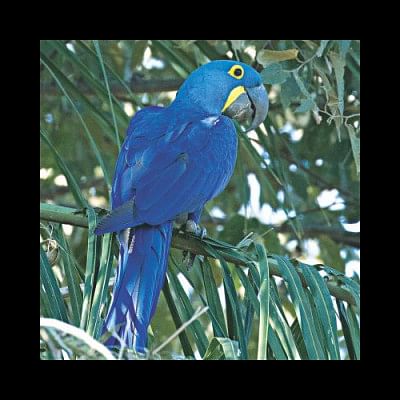Birds of Brazil

The Hyacinth Macaw has to be seen to be believed. The world's largest parrot, with big mischievous eyes, is coloured deep blue with splashes of yellow. It is an endangered species and one of the 1900-odd types of birds found in Brazil.
Brazil, the fifth largest country in the world, occupies 3.27 million square miles. It has more variety of living species than any other country. Within its borders are many types of terrain, vegetation and climate. These translate to different types of habitats for birds. Some of the regions of Brazil with bountiful birds are the wetlands of Pantanal, the savannah of the Cerrado, the Amazon rainforest and the Brazilian highlands.
Brazil was the first South American country I visited. Its bird variety as well as other wildlife, such as jaguars, drew me to the country. But what I had not realized was how colourful the birds are in South America. Once in Brazil I saw that entire families of birds, such as Dacnis, Tanagers, Toucans and Macaws seem to compete with each other in wearing bright colours.
There are birds of all sizes, from the flightless Greater Rhea, about 2 meters tall and weighing thirty kilograms which I saw in the fields of the Pantanal, to tiny hummingbirds which I saw in Amazonia.
Not to be outdone, there are around forty species of raptors – birds of prey – of many shapes and sizes, from the imposing Harpy Eagle to smaller Caracaras and Hawks.
There are strange looking birds such as the Potoo and the Hoetzin. I saw the latter, with a large crest of hair protruding from its small head, looking like something out of Harry Potter. The Potoo eluded me.
One of my best memories was watching Roseate Spoonbills, pink-red birds the size of egrets. Along the bank of the Paraguay river, on the top of several adjacent tall trees, they had their rookery and birds flew in and out with nesting material and food.
Birds seemed friendlier and more accessible in Brazil than they are in Bangladesh. Other than the obvious sparse population, another reason is that Brazilians are extremely serious about conservation. For example, Harpy Eagle nests are jealously guarded and Hyacinth Macaw's favourite trees are left alone. Hunting of all wildlife has been illegal since 1967. And jaguar and caiman (crocodiles) populations have rebounded in the Pantanal after locals decided – correctly – that they would draw tourists.
I could not help comparing Brazil's birds with the birds – approximately 800 species - here in Bangladesh. There is no doubt that Brazil offers a more colourful and diverse menagerie of birds, most of them viewed easily. However, we have some strong points. We have more variety in ducks, especially during winter. We win hands down in kingfishers. None of Brazil's kingfishers is as beautiful as the kingfishers we find in Sundarban. Other birds that Brazilian birders may long for include our hornbills, pittas, sunbirds, bee-eaters and our crown jewel, the mysterious and rare Masked Finfoot of Sundarban.
From Alexander von Humboldt onwards, visitors and explorers have remarked on the beauty of South American birds when compared to those of other continents. From my short but productive visit to Brazil, I found myself in delightful agreement.
facebook.com/ikabirphotographs or follow ihtishamkabir on Instagram.

 For all latest news, follow The Daily Star's Google News channel.
For all latest news, follow The Daily Star's Google News channel. 



Comments